Royal Colwood Golf Club
British Columbia, Canada
Royal Colwood is a course imaginatively built for all levels of club golfers, a course built for the membership to enjoy year after year but even after almost 100 years of play remaining a course capable of challenging the very best players.
Early History and Founders
The more well-known Victoria Golf Club had opened in 1893 but by 1913 urban sprawl had pushed to the course’s boundaries, land taxes were rising precipitously and some of the more well-heeled members felt a country course would be a prudent move in case the VGC land was felt more valuable for housing.
Those individuals were among the most powerful in British Columbia and financing a second course was not a problem. Led by Joseph A. Sayward and James Dunsmuir, two of the wealthiest people on the West Coast of North America, the founders commissioned Arthur Vernon Macan, the reigning BC Amateur Champion, and recent Irish transplant to design a new course.
A 240 acre parcel of land was obtained in Colwood, a farming area located to the northwest of downtown Victoria. Construction on the course was started in 1913 and had progressed sufficiently that the first play on the course was in the in the summer of 1914. Prior to WWI, it appears the intent was to create a true country club and early mention is made of tennis, an equestrian centre and even a polo field. WWI interrupted all those plans and no mention is made of them after the war ended.
Arthur Vernon Macan – Royal Colwood Architect
RCGC was Arthur Vernon Macan’s first course. It was certainly one of his very best designs and today remains closer to its original layout than any of his other courses still in existence.
Macan grew up in Ireland and moved to Victoria in 1912. In his first year he had won the British Columbia Amateur and designed Royal Colwood, not bad for a new immigrant. However, the Great War intervened at this point and Macan joined countless other young Commonwealth men and took up arms. Indeed, he was one of the casualties of the war; while serving in the armed forces at Vimy Ridge he was wounded and eventually lost his left leg below the knee. His injury almost cost him his life and he convalesced for many months in the United Kingdom. But by 1919 he had recovered to the point that he played in a military tournament in England and shortly thereafter returned to Victoria.
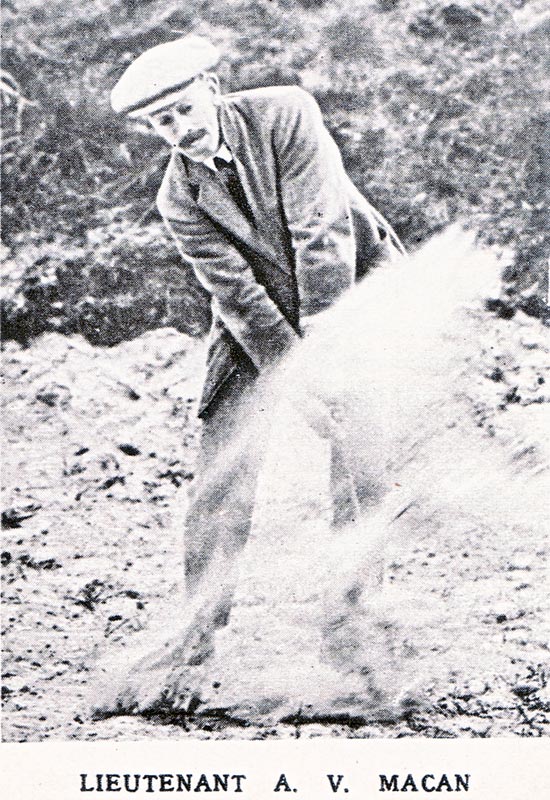 The Pacific Northwest Golf Association held its annual tournament at Royal Colwood in 1922, and the favourable reaction to the course by all the golfers set Macan upon his life’s work. With the boom in course design and construction that accompanied the 1920s, he found himself much in demand up and down the West Cost, working in all the major centers from Vancouver to San Francisco. His most well known courses include Shaughnessy and Marine Drive in Vancouver, Fircrest, Inglewood and Broadmoor in Seattle, Columbia Edgewater and Alderwood in Portland and California Golf Club in San Francisco. He died in 1964, still actively designing golf courses.
The Pacific Northwest Golf Association held its annual tournament at Royal Colwood in 1922, and the favourable reaction to the course by all the golfers set Macan upon his life’s work. With the boom in course design and construction that accompanied the 1920s, he found himself much in demand up and down the West Cost, working in all the major centers from Vancouver to San Francisco. His most well known courses include Shaughnessy and Marine Drive in Vancouver, Fircrest, Inglewood and Broadmoor in Seattle, Columbia Edgewater and Alderwood in Portland and California Golf Club in San Francisco. He died in 1964, still actively designing golf courses.
The Macan Legacy
The founders of Colwood Golf and Country Club recognized Macan’s genius and contributions very early on. In a letter dated October 22, 1919, the club made Macan an Honorary Member, surely the first such member in the Club’s history. And thus was cemented the relationship between Macan and Colwood, a relationship that would last the rest of his life.
With the ongoing sponsorship of Joseph Sayward and Macan’s life membership, it is clear he stayed involved in the club until the time of Sayward’s death in 1934 and continued still in 1952, when he was retained to advise on the construction of new tees. That long term involvement is an opportunity very few architects and very few golf courses have been lucky enough to experience, and in the cases it has happened we frequently see those courses are among the very best work of that architect. Consider the following list: Donald Ross and Pinehurst #2, C.B. MacDonald and the National Golf Links of America, and Henry Fownes and Oakmont. Because these courses and architects both profited from a long partnership they are forever joined in our minds and the courses are regarded as among the best in the world. So it is with Macan and Colwood, and while the author makes no claims that Colwood should be considered in the same league as the list of courses above, there is no question that it is a great course and one that benefited enormously from Macan’s long term involvement.
The “Royal†in Royal Colwood
Royal Colwood is one of 66 courses permitted to use the “Royal†in its name, and one of six in Canada. That such a (then) isolated club should be so honoured is perhaps puzzling. However, Victoria is the capital of British Columbia and, as such, the seat of government for the Province. The Prince of Wales, later King Edward VIII, who in 1936 abdicated his throne to marry the divorced American Wallace Simpson, was a frequent visitor to Canada and to Victoria. Three times, starting in 1919, the Prince visited Victoria and Colwood Golf and Country Club. At the behest of his son, King George V permitted Colwood to become Royal Colwood in 1931. It is an honour the Club values highly, and we are proud to be one of the small family of “Royal†Golf Clubs throughout the world.
Historical Significance
Royal Colwood is truly one of the most architecturally significant courses in North America. When construction started in 1913 there were almost no courses on the continent that were more than rudimentary layouts, most used a plain geometric and penal layout of simple bunkering and featureless greens. While some pioneering architects were already working on the East Coast to build the modern type of course we are used to playing (C.B. MacDonald, Walter Travis and Donald Ross), all were at the beginning of their careers and the “golden age†of golf architecture had not yet begun. There were only a handful of courses that incorporated the sophisticated design techniques so prevalent at Royal Colwood and all were in the East.
Then, seemingly out of nowhere, came AV Macan and his revolutionary design of the Colwood Golf and Country Club. For the first time west of the Mississippi and one of the very earliest anywhere in North America, here was a course of great strategic interest and challenge. Some holes were doglegged, players were asked to think of where their drives should be positioned to offer the best angle into the green and rewarded handsomely for plotting their way properly around the course. Greens were challenging and featured slopes and rolls to hold the interest of players of all abilities. In other words, golf at Colwood was as much a thinking game as it was a physical game. Today there are many courses throughout the world with those features; in 1913 in North American it was virtually unheard of.
Nothing west of New York could match the sophistication and challenge of Macan’s design at Colwood. Consider that the great, and better known, West Coast courses – San Francisco Golf Club (1915), Pebble Beach (1919), Olympic Club (1924), Riviera (1926), Cypress Point (1928), Pasatiempo (1929), and many others – were not close to being constructed in 1913 and the importance of Royal Colwood begins to emerge.
Colwood opened for play in 1914, not fully completed but formed enough that the top golfers of the era recognized its great potential and revolutionary design. But that same year on June 28 the Great War erupted in Europe and the world turned away from recreational pursuits and concentrated on the ugly business of war making. Although Colwood Golf and Country Club remained open for limited play, all development on it stopped. With the cessation of the war in 1918, the world struggled to regain its peace time footing, and in 1919 and 1920 work resumed on the Colwood course and with Macan fully in control of its development. By 1921 the course was essentially finished and ready to make its debut on the golfing stage.
Course Description
Hole 1 – 392 Yards; The opening hole is a fairly straight forward par four of 392 yards. A tee shot to the left side of the fairway is rewarded by the best angle into the green, the only obstacle being a fairway bunker located 150 yards from the green. A tee shot to the right side of the hole may have to deal with a very large oak tree, although anything more lofted than a six iron will go over top.
The green is guarded by two bunkers, one to the left that is fairly shallow and a ball finding it will leave an uphill bunker shot. The one on the right is much deeper and, with the slope of the green, will result in a near impossible shot to leave close to the hole.
The green, however, is the real challenge of the hole. It slopes dramatically from the back right to left front, with all manner of interior slopes and hollows; it is one of the three or four most interesting and challenging greens on a course that is filled with great putting surfaces. There is tremendous variety to the possible hole locations, all with one common demand; do not be above the hole. The first is a very good opening hole that eases a player into the round but challenges the flat stick immediately.
Hole 2 – 409 Yards; The second continues the theme of easing the golfer into the round. It is a fairly short par four of 409 yards with a generous landing area. Two fairway bunkers have become obsolete for the modern golfer and are fairly easily driven over. There is not a lot of strategy to the drive, anything in the fairway will do. Well off the fairway there is a water hazard (usually dry) on the left and a hill with firs and oaks on the right.

The putting green is the first of three on the course that are not original, it is a basic two level affair with the ridge defining the levels running across the green. The old green site was immediately in front the present green and, inexplicably, the original greenside bunkers remain. They offer no challenge to the low handicap player and needlessly punish the high handicapper.
Hole 3 422 Yards; After two opening holes, Royal Colwood begins to reveal itself on number three. It is the first of three holes on the front nine that play straight away down long fairly generous fairways and then have their greens situated to one side or the other of the end of the fairway. The effect is a dogleg but not the construction. Playing down the right side will shorten the playing length of the hole but bring trees and OB into play, as well as requiring a second shot over a creek in front of the green that will run almost parallel to the approach shot. If that is not enough of a challenge, the green slopes from right to left so a draw will often run off into the rough; a fade from the right side is called for but if the ball does not fade, a watery fate awaits.
The more prudent play from the tee is down the left side of the fairway, although two bunkers in the landing area await the pulled or overdrawn tee shot. From there a mid to long iron approach must still carry the creek but at a better angle and more directly into the prevalent slope of the green. One of the very best holes at Royal Colwood, it remains almost exactly as originally designed and anyone leaving with a par four is well satisfied.
Hole 4 185 Yards; The first par three is perhaps the nicest looking hole on the course, with the tee shot being played over a very natural pond to a green tucked into a grove of firs, with a specimen oak and the clubhouse in the background. There are a number of tee decks to use, with the Gold tee distance ranging from 155 to 210 yards depending on the deck used and the hole location, and the angle into the green also varies tremendously depending on the tee. From the back left tee deck, the player is asked to play a draw into the green, and from the right tee deck a draw or fade may be called for, depending on the hole location.
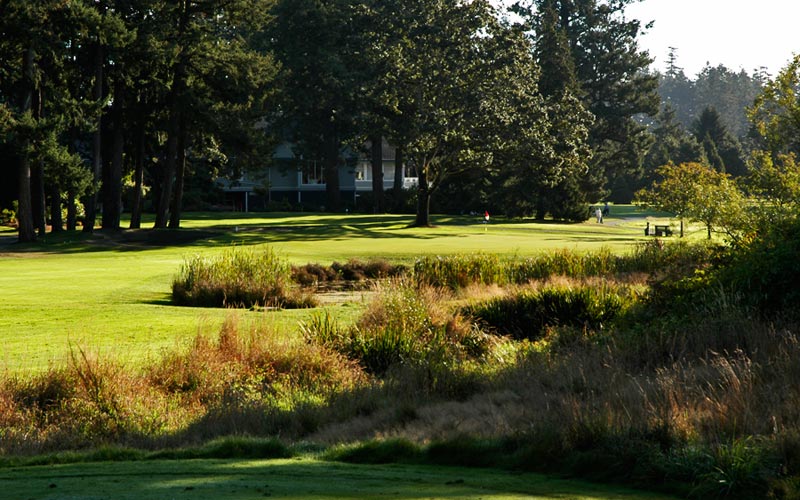
The green is guarded on the left by two bunkers and on the right by the pond. The green slopes from left to right, with the left third of the green severe enough that hole locations are not possible. The right edge of the green rolls down into the pond but if the rough is long enough it will prevent the ball from reaching the water. The slope of the green makes sure the player is challenged regardless of the putt. A hole where a two is possible as is five, the hole remains as first built, although recent tee decks have added length.
Hole 5 – 522 Yards; The first of two par fives on the course, the fifth hole was once a very formidable challenge that, if technology and nature have lessened its difficulty, still remains a beautiful and challenging hole. The tee shot requires a fade by the longer hitters as the hole bends around an impressive stand of firs on the right. A straight or pulled tee shot will find itself in more trees on the left. The player also needs to be aware of a diagonal ridge running through the fairway that will throw tee shots off to the left side trees. From the landing zone, the player can play a simple mid iron to lay-up, or play more aggressively with a fairway wood to get near the green. The second shot, until three years ago, was much more challenging. There were a pair of large specimen oaks at the 150 yard mark that beautifully framed the hole and put more of a premium on the tee shot and second shot. Unfortunately, the left oak fell in a winter storm, and, while replacements have been planted, it will be many years before they present the aesthetic beauty and strategic challenge presented by the old tree. The green is large with all manner of subtle plateaus and ridges; any putt over twenty feet is going to present a challenge. The green is bunkered on the left and right sides. The hole at present is exactly as originally designed, except for two forward tees that were built in 2002.
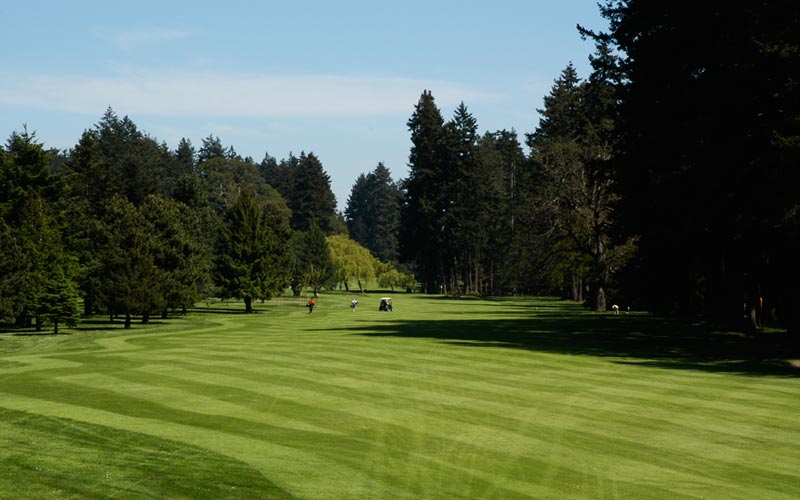
All in all a gorgeous hole, especially when the afternoon shadows reveal the gentle contours of the fairway and green, and one that is fun to play and offers a birdie opportunity when it is played well.
Hole 6 – 429 Yards; The sixth is one of Royal Colwood’s great holes and is the second hole on the front nine to feature a straight fairway, with the green perched to one side, this time on a large plateau to the left of the fairway. The landing zone is defined by a diagonal ridge that runs away from the tee from left to right, and the bold player, by going down the left side of hole, will try to land on the back side of the ridge to gain additional yardage. The risk of that strategy is going a shade (or a lot) left and risk having the second shot partially or fully blocked by a stand or firs and an oak tree; it is a narrow power alley.
The more prudent play is to go down the right side. The cost is a longer approach into the green but a more generous landing area. There is a great deal going on between the landing area and the green. There are two smallish mounds that may provide challenging lies for the longest drives. To the left are two bunkers approximately 100 – 120 yards from the green. They are not in play for the better player but, with the elevated green, they do present a challenge with depth perception. Macan was very adept at fooling the player’s eye about how far a green site was, and this is one of his better examples. There is a left greenside bunker set about ten yards from the edge of the green that is in play only infrequently but a bunker on the right side sees much more action and is quite deep. The green falls gently (for Royal Colwood) from the back left back to front right and some hole locations definitely favour an approach from the right side of the fairway. The green itself has a lot of interesting internal movement to keep up the challenge of this hole right to the end. The sixth is another where all golfers will leave happy with a par.
Hole 7 – 164 Yards; The second par three on the front is a downhill affair, 164 yards from the back tees. It is not a difficult hole but has a great deal of charm and beauty. The tee shot is played out of a chute of mature firs and over a rock outcropping. The trees block the wind at ground level and cause it to swirl higher up. The player must correctly judge the effect of the elevation change, wind and hole location to pull the correct club, not always an easy task.
The green is guarded by a trio of bunkers along the right side and by another short left. A hill on the left bleeds into the middle of the green and there is pronounced knob at the front of the green. The green generally falls from left to right but somehow the break is never what it appears. A really nice par three that offers a chance for birdie but that charms even if the score is a four.
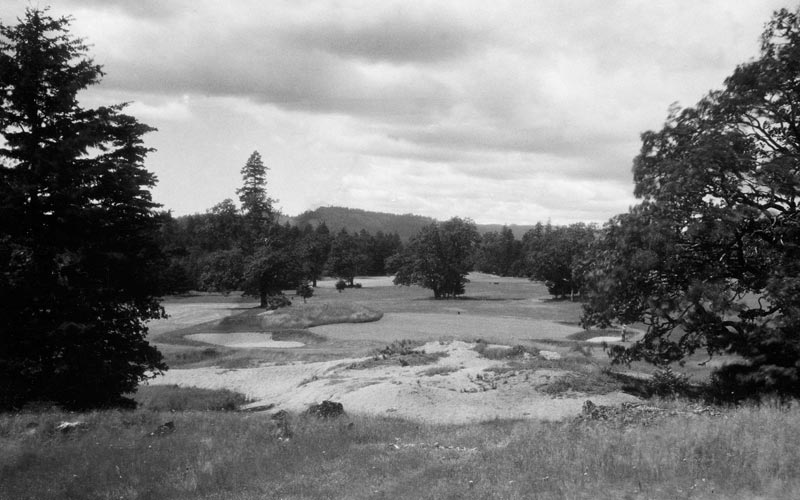
The seventh hole circa 1930.
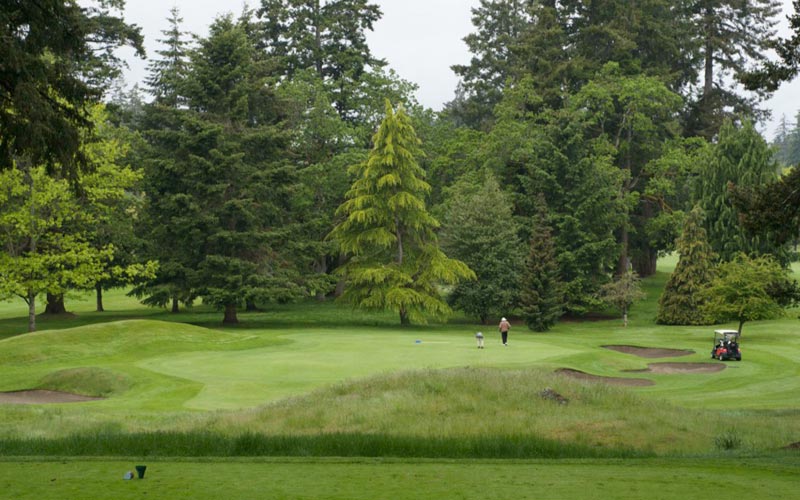
The seventh as seen today.
Hole 8 – 326 Yards; The eighth hole is a short par four framed by a line of oak trees on the right and firs on the left. The decision off the tee is which club to use and there is a wide variety of choices. For the long hitter, driver will often be pulled because, although the opening to the green is quite narrow, there is usually more reward than risk, and if pushed a bit right will probably clear most of the troubles presented by the oaks. From a generous landing area at 160 yards from the tee, the fairway narrows considerably as it gets closer to the green, and for mere mortals, depending on confidence levels of the day, anything from a six iron to three wood may be chosen. The tee shot should favour the left side to provide a better angle to a green that appears quite flat but where the ball always seems to break more than expected. The real challenge is with a front hole location where fairly deep bunkers are left and right and the front part of the green slopes quite precipitously from right to left. The eighth is a very nice short par four, and together with the seventh, offers a respite before the course bares its teeth on holes nine–thirteen.
Hole 9 – 444 Yards; The ninth begins a run of five terrific holes that, if finished in level par, is an accomplishment to be savoured. It is the final hole on the front nine to feature a straight fairway, with the green perched to one side, this time on a largish plateau to the right of the fairway; it is in many ways a mirror image of the sixth. Again, we are asked to decide our strategy for the hole on the tee. Play down the right side and the hole plays a bit shorter and the approach will be made from a better angle into the green. However, a series of cedars and oaks awaits a tee shot that even thinks of trickling into the rough and the driving range, which is Out of Bounds, lies just beyond the trees.
The left side is the safer route but two bunkers pinch the landing area and the approach shot must be played diagonally into the green. The green is guarded by a long bunker on the left side and a smaller blind bunker on the right. The green itself slopes from front to back and also features a false side on the left that collects balls and leaves a testing chip or putt. All in all a very challenging but intriguing hole, and a hard earned par.
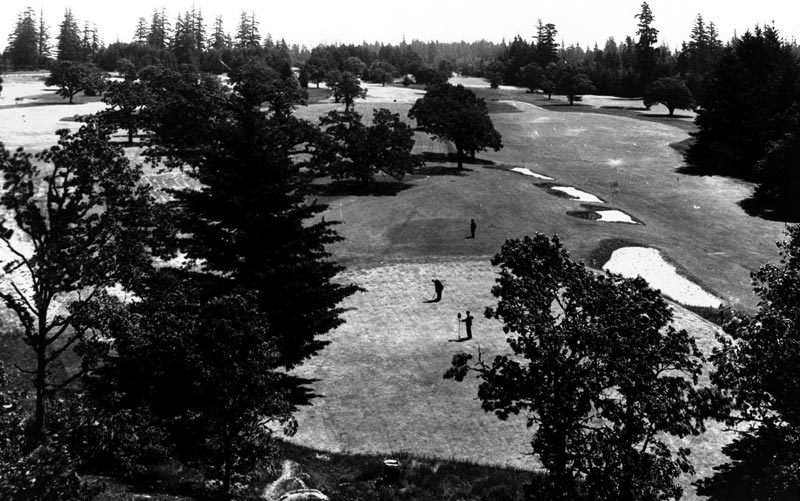
The ninth green, with old cross bunkering.
The bunkering has changed from the early days when a series of four cross bunkers ran along the brow of the plateau (see photo). It made for a great visual but, as with cross bunkering in general, they lost favour many years ago.
Hole 10 – 430 Yards; As we make the turn, we now play a dog leg-right hole for which the tee-shot is narrow, guarded on the left by a wood, on the right by the out of bounds. The longest hitters will need to fade the ball or run into some trees at the end of the fairway, or perhaps take a three wood. The rest of us can use driver and try to position the ball in the middle of the fairway. Too far right and we will be blocked out by a grouping of firs.
The approach shot is fairly straightforward, to a green bunkered on both sides and relatively flat. As with all of Colwood’s greens, however, it has countless small borrows, ridges and plateaus. The tenth is a good hole and a challenging and rewarding par.
Hole 11 – 236 Yards; We come now to the second hole on the course that has a new green. The original green was replaced in the 1980s as green speeds began to increase and the slopes here were considered too severe. Together with the severe greens on twelve and thirteen, this would have been a run of holes that only the best putters could play well, and then, perhaps, only with a good measure of luck. The replacement is another two-level construction, similar to the second hole but somehow this one fits in a bit better with its surroundings.

The eleventh green (with Murphy).
A long par three, the tee shot demands accuracy from the tee, with fir trees catching a ball to the left and rough to the right. It is guarded by a bunker on the front left of the green and another (largely out of play) to the back right. The bunkering is not in the style of most bunkers in the course and both are candidates for significant renovation. The green is large and the ridge in the middle puts a premium on ball placement. From the Gold Tee, this is a brute of a hole, miss to the left and four becomes a good score. It continues the run of strong holes and par is a very good score.
Hole 12 – 446 Yards; We come now to without question the most difficult hole on the course, but also one of the very best. A blind tee shot up to a raised fairway requires distance control, as the fairway narrows the further you go and begins to tilt noticeably from left to right. In the summer a well hit driver is likely to roll into the firs to the right of the landing area. The accompanying photograph demonstrates the stands of firs on both sides of the fairway, although the landing area out to the right is more generous than the photograph suggests.
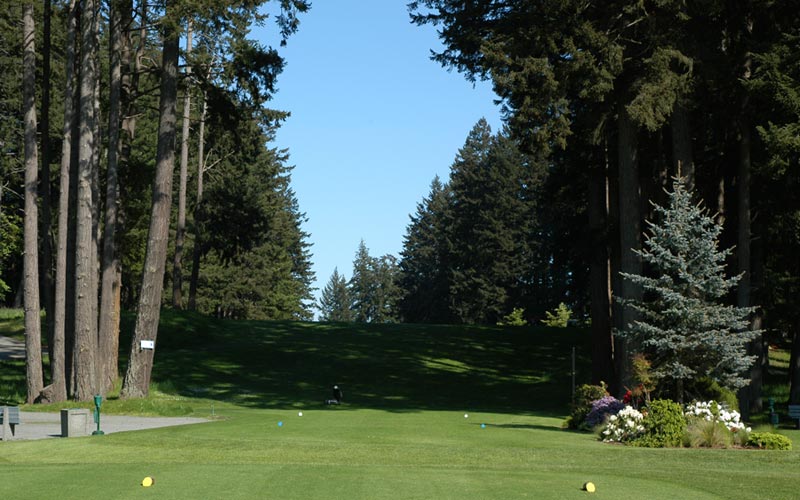
The view from the twelfth tee with its blind tee shot.
After deciding on the correct club, aim at the opening in the trees on the horizon that frame the fairway and, when properly executed, your tee shot should kick slightly to the right-center of the fairway. A prudent tee shot will leave approximately 200 yards to the middle of the green and give you the best angle for a long approach into the green. All but the highest ball strikers will find the green extremely difficult to hold and the hole from this distance is designed to reward a running approach.
The long driver might be rewarded with a 150 yard approach shot that will allow more aggression in planning and execution, but more often than not the player will be deciding how to punch out or bend a low draw or fade from under or around trees: this is not a hole to be aggressive with.
There is a pronounced dip before the green that will kick a low running shot forward but hitting into the upslope will surely lead to the ball coming up short. The green is notorious for its treachery, sloping from back left to front right, with a false front on the right. Any shot ending up above the hole will leave an extremely delicate and testing putt, with a real possibility the next shot will be played from off the green. Even a short putt will be testing and keep the nerves twitching until the ball finds the bottom of the cup.
The hole remains exactly as originally designed and does not require any changes, it is a great hole, and among the most difficult par fours anywhere. Even for the low handicap player a six is a more frequent result than a four.
Hole 13 – 397 Yards; And now to the thirteenth, a short hole that plays 397 yards from the Gold tees but one that has caused the end of many good rounds. It starts from an elevated tee to a fairly generous fairway. Not for the first time positioning off the tee can determine how easy the hole plays. Going down the left side provides an easier drive, although fairway bunkers and trees will catch the errant shot. The right side is the preferred line into the green but here larger trees, closer to the ideal line of play, wait to block out a shot missing the fairway. A creek runs in front of the green and a beautiful pond is situated to left and in front. The pond only comes into play for the poorest of approach shots but it certainly exerts its siren call to the player.
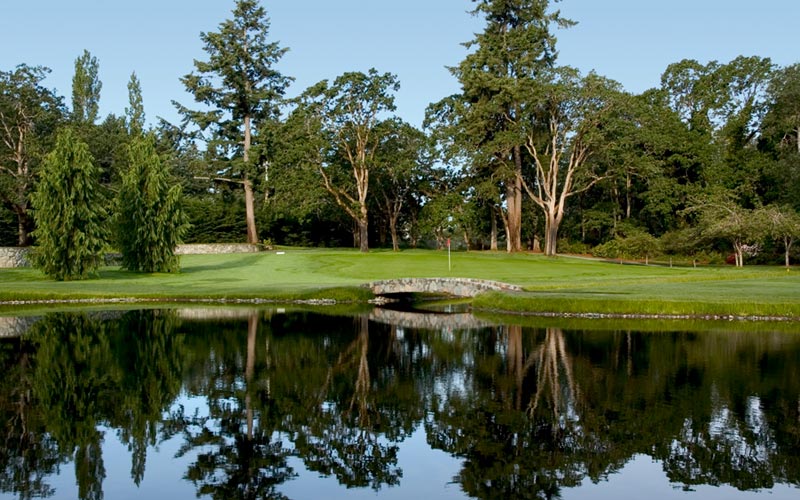
The view of the thirteenth green.
The green is the main defence of the hole, and what a defence it puts up! It slopes dramatically from left back to right front and has a pronounced ridge angled through the middle of the green. Positioning is absolutely critical here, anything above the hole invites a three putt – or worse – and shots ending up more than fifteen feet or so to the left or right of the day’s hole location are going to break severely, twenty feet of break on a forty foot putt is not unusual. The severity of the green is such that it may be a more difficult hole for the very good player than merely the good player. Both will be playing a short iron for the second shot but with the amount of spin the really good player imparts, a ball can easily end up off the front of the green even when played to the back shelf. This green can ruin a good round, or set you up for a strong finish.
This is a great hole, the end of a run of five great holes in a row, and while birdie is possible, lose focus for even a second and you may well be writing down a six on your scorecard.
Hole 14 – 491 Yards; After a gruelling but exhilarating stretch of holes, we now come to the short par five fourteenth. Here we can unwind on the drive and hope to get home in two. While for the last while par was foremost in everyone’s mind, here visions of birdie or better take over.
The tee shot is somewhat elevated to a generous fairway. The line chosen by each player will depend on their preferred shot shape, a fade or draw both work. A well struck drive will leave a long iron or perhaps hybrid club into a long green that slopes back to front and runs off at the edges. Bunkers on the left and right front guard the green. The usual internal plateaus and slopes challenge the player but this is a birdie hole, and a welcome relief after the previous holes.
Hole 15 – 156 Yards; The fifteenth is the final par three on the course; it is short but nevertheless challenging. What appears to be a relatively flat hole is actually uphill and the player should always be mindful that he has enough club. In addition, if you can’t feel any wind on the tee-box it is, nevertheless, usually present. Elevation and wind combine to usually make for a one or two club difference from what might initially be the player’s first thought of club for the tee shot. Proceed carefully.
The fifteenth presents another challenging green that slopes from back right to front left, and rewards careful shot placement, anything above the hole will require a delicate putt. And, in a now common theme, the green is effectively contoured with plateaus, punchbowls and ridges featured throughout. It is another of Colwood’s best putting tests. The green is guarded on the left and right by bunkers, but with the slope of the green, the right bunkers demand a very difficult recovery shot.
This hole originally played 185 – 190 yards but financial pressures forced selling a corner of the golf course some years ago and yardage was lost as a result. Before that time, as a long par three with a sloping green, it would have accepted only the best of tee shots and offered a very exacting test.
Birdie is possible here but, with the chance to three-putt, so is four. The hole completes the four par threes on the course, each one very different from the other but each is a very, very good hole.
Hole 16 – 385 Yards; Legend has it that the sixteenth put the “Royal†in Royal Colwood. The Prince of Wales was said to have commented that playing the sixteenth hole was like “playing in a cathedralâ€, with firs on the left and right and several magnificent specimen firs standing sentinel behind the green, and that it was his favourite hole. Whether the story is true or apocryphal, the hole is a stunning sight from the tee. It’s time to take a deep breath and smell the fresh air, golf should be enjoyed for its beauty as well as its challenges.
A drive down the left side of the fairway will give the best angle into the green but it is not as important as with some of the other holes on the course. The green itself is the third one built for the hole – the beauty of the firs is offset by the challenges they bring in growing good turf. Unlike the two other new greens on two and eleven, this one fits in very well with the character of the original course. It slopes from back right to front left and, again, placement with the approach shot is key to scoring well. The green is larger than appears from the landing area but beware the cross country putt, it is likely to end in a five.
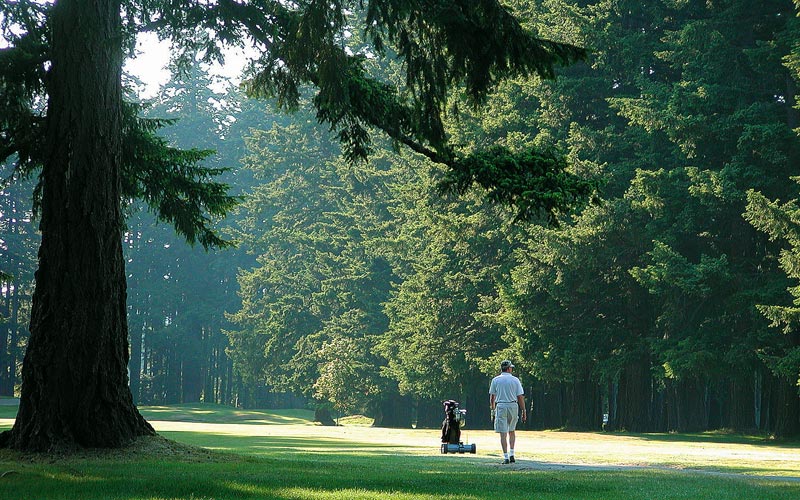
A stroll down the sixteenth fairway.
The bunkering at the green is another story; there is a bunker in front that in placement and shape does not fit in with the course. Another elevated bunker to the back left similarly does no justice to the hole. Both are candidates for replacement in the planned bunker project, and good riddance to both. The sixteenth is a very nice start to the finishing run of holes at Royal Colwood.
As you walk to the next tee, be sure to check out the plaque at the base of the big fir behind the green; it’s five hundred years old and 250 feet tall.
Hole 17 – 398 Yards; The seventeenth starts with a very demanding tee shot from an elevated tee, and requires a slight right to left drive to one of the narrowest fairways. A draw that turns into a hook will be captured by firs but there is a bit more room out to the right. Although the long hitters will want to maximize their drives, a more prudent play might be down the right with a fairway wood.
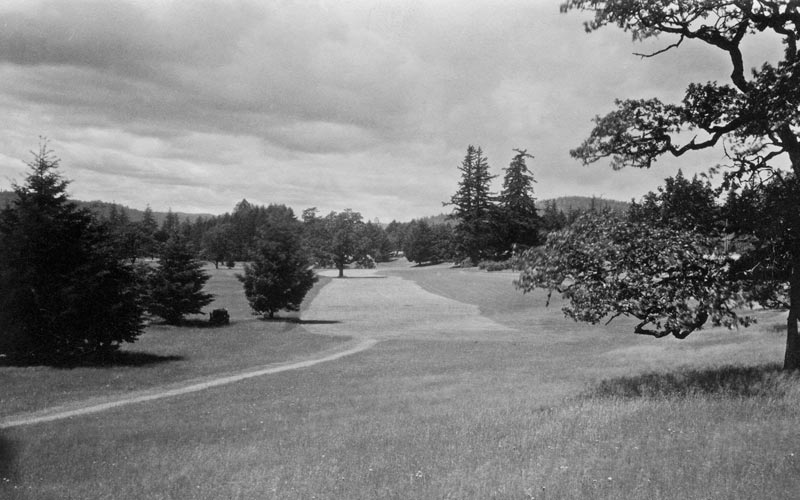
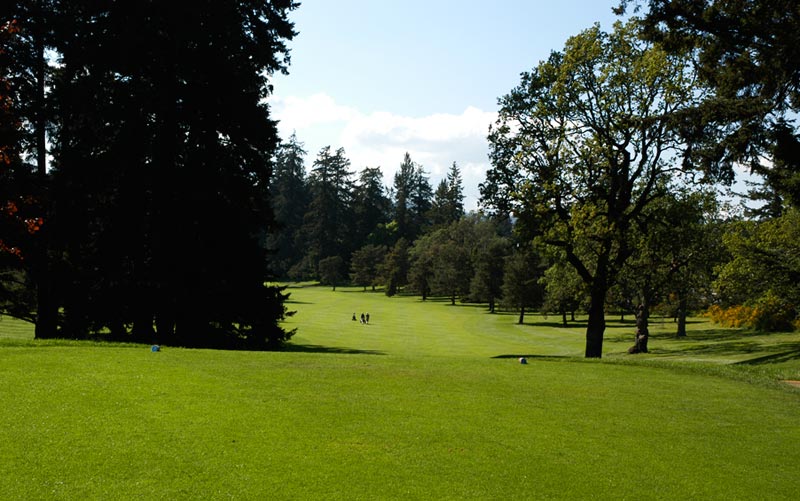
Seventeen then and now – note the two firs in the left foreground then and now.
From there a mid to short iron approach requires precision to place it on the correct area of the green. If previous greens feature challenging contours, this one appears to have been built on dead elephants and abandoned Volkswagens! While it takes some local knowledge, it is also great fun, and looks more intimidating that it really is. Bunkers guard the left and right of the green but the key is in the drive, find the fairway and the approach will largely eliminate the bunkers for the approach. There are three fairway bunkers that no longer come into play for all but the most errant of shots by the high handicap player. They reflect a bygone day when reaching a 400 yard hole in two was a real test and involved a run-up approach.
Hole 18 – 448 Yards; If a great course needs a great finishing hole, the eighteenth at Royal Colwood provides it, and it starts with the most demanding drive on the course. A carry of approximately 225 yards is required to reach the top of the plateau fairway. A drive slightly pulled or pushed will find trouble from trees on both sides and, on the left, from two bunkers. Miss to the right and bogie will come into play, miss to the left and bogie becomes a good score and double a distinct possibility.

From the eighteenth tee to the landing area.
The hole doglegs to the left at the landing area, and the approach plays to a shallow green with O.B directly behind. Macan cleverly constructed the hole so that, while the fairway to the green appears flat, it actually gradually rises, so that the flat green is eye level from the landing zone. All sorts of depth perception problems arise and distance control becomes paramount. There is a large oak to the right that protects that part of the green, a smallish bunker to left and a severe drop-off also to the left. Put together, these features suggest a conservative play to the middle of the green, usually with a long to middle iron, or perhaps a hybrid.
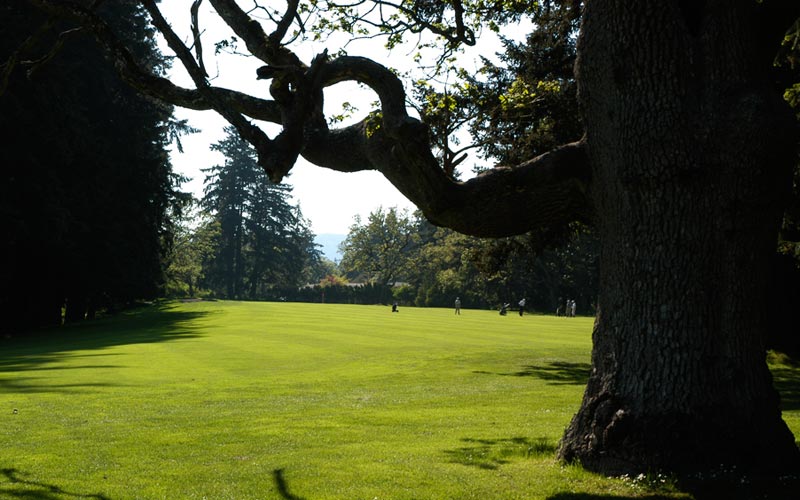
Looking down the eighteenth fairway to the green.
The green itself is by far the flattest on the course, with only the most subtle of breaks to be found. After the drama of the previous seventeen holes, this is a bit disconcerting and offers a different challenge, the temptation is to read more break into putts than is there. The eighteenth is a strong finishing hole for which par is a good score.
Royal Colwood Today
Although nearly 100 years old, the Royal Colwood course retains most of its original design characteristics. Fifteen of the original greens remain as originally built, the routing is exactly the same and many of the original bunkers remain, although time and human interference have changed their shape and design features. Approximately 400 yards has been added to the original 6,250 yard length of the original layout and most tee decks have been enlarged to accommodate the increased play the course has received over the years.
A “Master Plan†was commissioned in 1984, and as was the fashion in those days, it called for a substantial modernization of the course. Holes were to receive artificial mounding at the greens, many bunkers were to be eliminated or moved and some greens were identified for rebuilding. The first phase of the plan was implemented and the results were not met with favour by the membership. Thankfully nothing further from the plan was implemented.
Today, in 2009, the Club is actively planning to undertake a significant restoration. The original bunkering style is to be reintroduced, fairway bunker locations will be adjusted to reflect the modern game and the original green surfaces re-established (some have been considerably reduced over time). When completed, Royal Colwood will again stand as a testament to its unique place in the history of golf in North American and as proof of the genius of Arthur Vernon Macan.
The End








